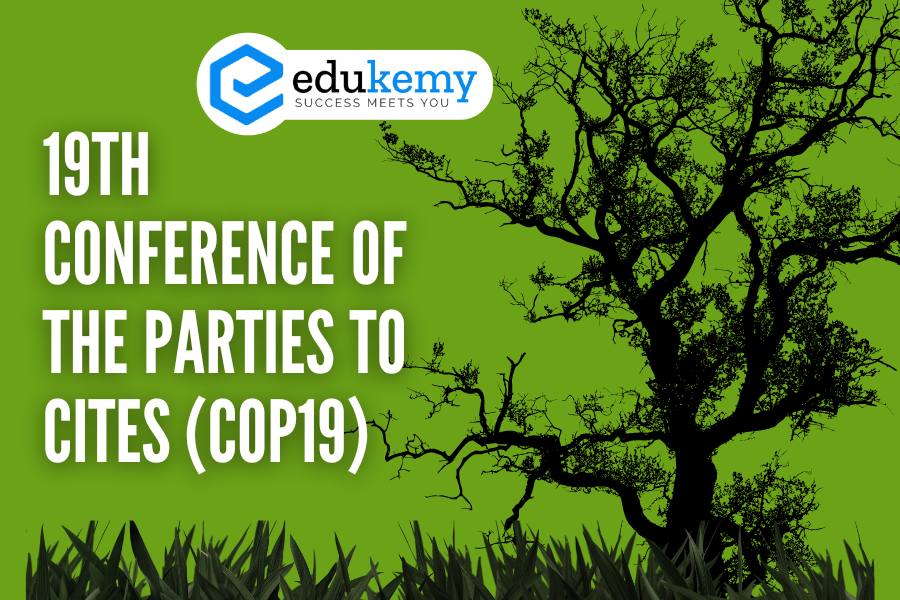- The 19th Session of the Conference of the Parties (CoP19) to the Convention on International Trade in Endangered Species of Wild Fauna and Flora (CITES) is currently taking place in Panama City.
- CoP19 is alternatively referred to as the World Wildlife Conference.
Contents
KEY HIGHLIGHTS OF CONFERENCE:
- Numerous Proposals: The conference featured 52 proposals addressing international trade regulations for a diverse range of species, including sharks, reptiles, hippos, songbirds, rhinos, 200 tree species, orchids, elephants, turtles, and more.
- India’s Shisham (Dalbergia sissoo): India’s Shisham (Dalbergia sissoo) has been included in Appendix II of the convention, necessitating compliance with CITES regulations for the trade of this species.
- Relief for Dalbergia sissoo Exports: The conference introduced a relief measure by easing CITES rules for the export of products derived from Dalbergia sissoo. This move is anticipated to enhance Indian handicraft exports.
- Sea Cucumbers in Appendix II: A proposal to include sea cucumbers (Thelenota) in Appendix II of the Convention was accepted. A recent analysis by the Wildlife Conservation Society-India revealed sea cucumbers as the most trafficked marine species in India from 2015-2021.
- Trafficking Analysis: A study by the Wildlife Conservation Society-India highlighted Tamil Nadu as the state with the highest number of marine wildlife seizures from 2015-2021, followed by Maharashtra, Lakshadweep, and Karnataka.
- Support for Freshwater Turtle Proposal: India’s proposal for the inclusion of the Red Crowned Roofed Turtle (Batagur kachuga) in CITES Appendix gained widespread support at CoP 19. The initiative was well-received by the participating parties.
- Appreciation for Operation Turtshield: Operation Turtshield, India’s initiative to combat wildlife crime, received appreciation at the conference for its efforts in this regard.
- Recognition of Wildlife Protection Act 1972: India emphasized that many critically endangered, endangered, vulnerable, or near-threatened species of turtles and freshwater tortoises are already afforded high degrees of protection under the Wildlife Protection Act of 1972.
- Abstention from Ivory Trade Proposal: India decided not to vote against a proposal seeking to reopen international trade in ivory during the ongoing conference.
CITES
- CITES, or the Convention on International Trade in Endangered Species of Wild Fauna and Flora, is an international agreement involving 184 governments.
- Its primary objective is to ensure that the global trade in wild animals and plants does not pose a threat to the survival of these species.
- The convention came into force in 1975, and India became the 25th party, voluntarily agreeing to be bound by the Convention, in 1976.
- While CITES imposes legal obligations on the Parties, mandating them to implement the Convention, it does not replace national laws.
- The Conference of the Parties convenes every two to three years to assess the Convention’s implementation.
- This meeting serves as a platform for Parties to review progress, discuss amendments, and ensure that the objectives of CITES are effectively pursued.
FAQs: 19th Conference of Parties to CITES (CoP19)
1. What is the 19th Conference of Parties to CITES (CoP19)?
A: CoP19 is the 19th Session of the Conference of the Parties to the Convention on International Trade in Endangered Species of Wild Fauna and Flora (CITES). It is currently being held in Panama City.
2. What are the Key Highlights of CoP19?
- Numerous Proposals: The conference addressed 52 proposals concerning international trade regulations for various species, including sharks, reptiles, hippos, songbirds, rhinos, 200 tree species, orchids, elephants, turtles, and more.
- Inclusion of Shisham in CITES: India’s Shisham (Dalbergia sissoo) has been included in Appendix II of CITES, requiring compliance with CITES regulations for its trade.
- Relief for Dalbergia sissoo Exports: CITES rules for the export of products derived from Dalbergia sissoo were eased, aiming to boost Indian handicraft exports.
- Sea Cucumbers in Appendix II: Sea cucumbers (Thelenota) have been included in Appendix II of the Convention, based on recent findings that identified them as the most trafficked marine species in India from 2015-2021.
- Trafficking Analysis: A study revealed Tamil Nadu as the state with the highest number of marine wildlife seizures, followed by Maharashtra, Lakshadweep, and Karnataka.
- Support for Freshwater Turtle Proposal: India’s proposal for the inclusion of the Red Crowned Roofed Turtle (Batagur kachuga) in CITES Appendix gained widespread support.
- Appreciation for Operation Turtshield: India’s initiative, Operation Turtshield, aimed at combating wildlife crime, received appreciation for its efforts.
- Recognition of Wildlife Protection Act 1972: India emphasized that several species of turtles and freshwater tortoises, categorized as critically endangered, endangered, vulnerable, or near-threatened, are already highly protected under the Wildlife Protection Act of 1972.
- Abstention from Ivory Trade Proposal: India decided not to vote against a proposal seeking to reopen international trade in ivory during the conference.
3. What is CITES?
A: CITES, the Convention on International Trade in Endangered Species of Wild Fauna and Flora, is an international agreement involving 184 governments. It aims to prevent the global trade in wild animals and plants from threatening the survival of these species.
4. When did India join CITES?
A: India became the 25th party to CITES in 1976, voluntarily agreeing to be bound by the Convention.
5. How does CITES operate alongside national laws?
A: While CITES imposes legal obligations on Parties, it does not replace national laws. All transactions involving the import, export, and re-export of species protected under CITES must be authorized through a permit system.
In case you still have your doubts, contact us on 9811333901.
For UPSC Prelims Resources, Click here
For Daily Updates and Study Material:
Join our Telegram Channel – Edukemy for IAS
- 1. Learn through Videos – here
- 2. Be Exam Ready by Practicing Daily MCQs – here
- 3. Daily Newsletter – Get all your Current Affairs Covered – here
- 4. Mains Answer Writing Practice – here

